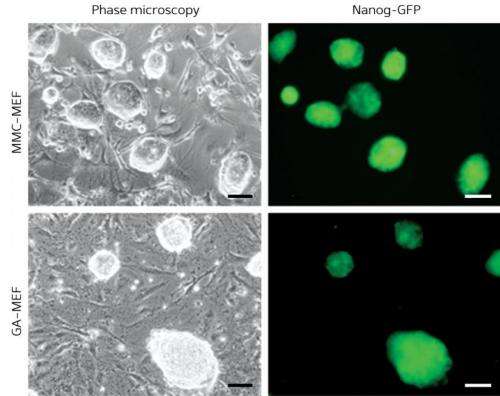Stem cells thrive on superficial relationships

Stem cells are renowned for their capacity to develop into a wide range of mature cell types but they cannot maintain this flexibility on their own. In the body, neighboring cells help maintain this ‘pluripotent’ state. But to grow these cells in culture, scientists have had to devise a variety of specialized techniques.
This is especially true for embryonic stem cells (ESCs) and induced pluripotent stem cells (iPSCs), which are ESC-like cells derived from adult tissue. To preserve their pluripotency, these cells have typically been grown atop a supporting layer of ‘feeder cells’. Now, a strategy developed by a team led by Yoshihiro Ito at the RIKEN Advanced Science Institute, Wako, promises to make ESC and iPSC cultivation considerably easier.
Feeder cells provide valuable growth factors for stem cells but also make culture complicated and create opportunities for contamination—an especially serious concern for clinical applications. Early attempts to isolate the key features of feeder cells have fallen short. “It was difficult to culture stem cells on growth-factor immobilized substrates,” says Ito. “Feeder cells provide a complex microenvironment that cannot simply be replaced with one or several growth factors.”
As an alternative, the researchers subjected feeder cell layers to chemical ‘fixation’ treatments that killed the cells while physically preserving them and maintaining their external structure largely intact. This resulted in a robust cell culture surface that retained virtually all of the features with which stem cells would typically interact. Mouse iPSCs maintained their pluripotent state even after extensive cultivation on feeder cells that had previously been fixed with either formaldehyde (FA) or glutaraldehyde (GA). GA fixation is a harsher treatment, but Ito and colleagues noted that GA fixed cells also provided a superior substrate, and this GA-fixed layer was robust enough to be washed and reused.
The researchers were pleasantly surprised to find that mouse iPSCs grown in this manner were virtually indistinguishable from those cultured by traditional methods (Fig. 1). “Feeder cells were believed to secrete proteins or other compounds that maintain the growth of undifferentiated stem cells,” says Ito. “But fixed cells lose this secretion capability, which shows that providing the right contact microenvironment is more important for iPSCs.” Given how rugged the fixed cell layers are, he anticipates that this approach could offer a commercially viable cell culture tool once it has been tested and optimized for cultivation of human iPSCs.
More information: Yue, X.-S., Fujishiro, M., Nishioka, C., Arai, T., Takahashi, E., Gong, J.-S., Akaike, T. & Ito, Y. Feeder cells support the culture of induced pluripotent stem cells even after chemical fixation. PLoS ONE 7, e32707 (2012). www.plosone.org/article/info%3Adoi%2F10.1371%2Fjournal.pone.0032707
Provided by RIKEN

















